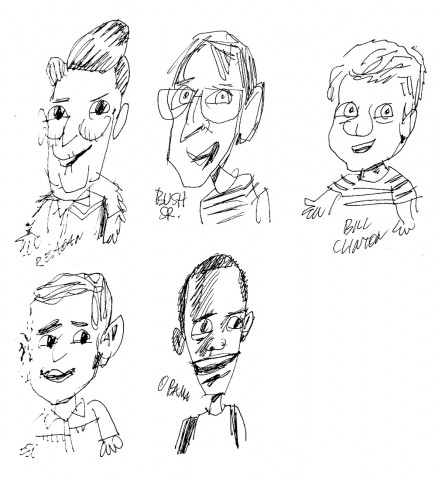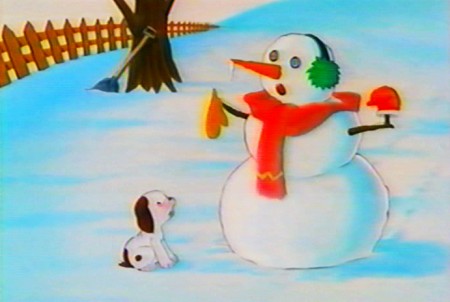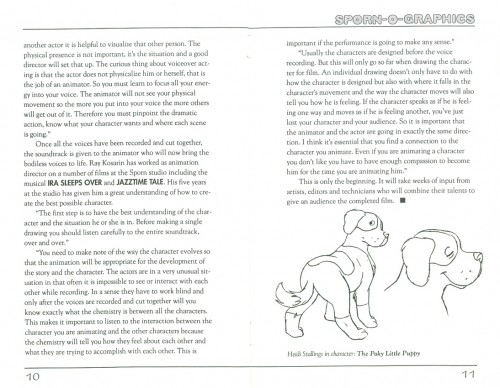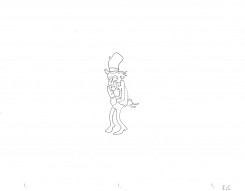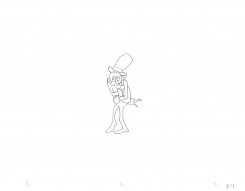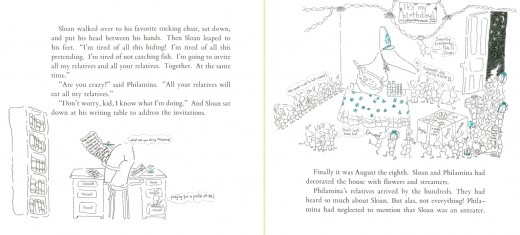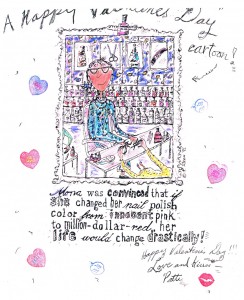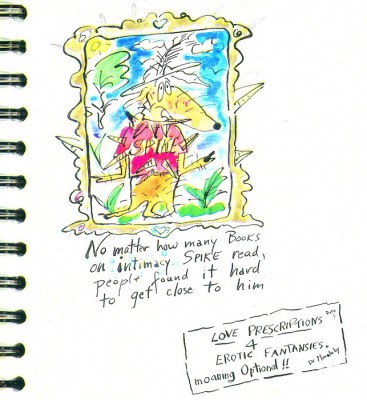Category ArchiveSpornFilms
Commentary &SpornFilms 28 Apr 2011 07:28 am
Ends and Odds

The ASIFA East Animation Festival will be held on this coming Sunday, May 1st.
Tishman Auditorium, The New School. 66 West 12th Street.
As always, admission is free. So is the party after the show.
________________________
- We just received the poster for our upcoming half-hour program for HBO, I CAN BE PRESIDENT. The show will air, for the first time, on June 22nd and will be repeated ad infinitum after that. HBO is throwing a party for it on May 26th; I’ll take some pics, if anything interesting happens, and post them.
The poster is a mishmash of part of a scene from the show with other elements thrown at it. The type is less than I would have liked. I have difficulty with the mix of translucent and opaque colors (something I would never do), so I asked them to put a white border around it. The poster originally bled from the page. Hopefully, this takes a bit of the onus off it. Hey, what do I have to complain about! They made a poster!
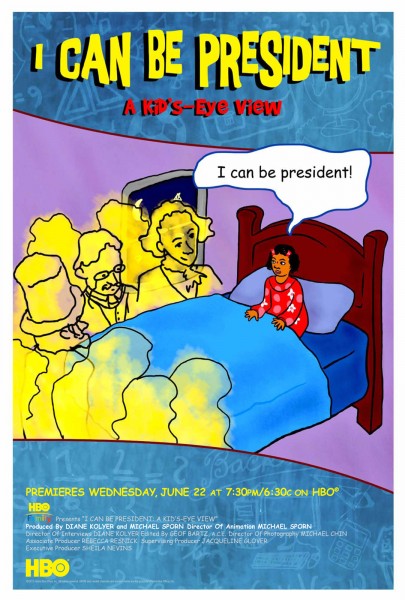
The poster for our show, I CAN BE PRESIDENT
Key to this show was the work of animators Matt Clinton and Katrina Gregorius. They both had a big hand in making anything that is “Special” in the show Special.
- As part of the Tribeca Film Festival, Saturday at 7:00pm there will be a NYWIFT “Independent Women” screening and panel.
 The films to be screened include:
The films to be screened include:
Pastorale (1950, dir. Mary Ellen Bute),
Divination (1964, dir. Storm de Hirsch),
Windy Day (1967, dir. Faith Hubley),
Zenscapes (1969, dir. Marie Menken),
Anything You Want to Be (1971, dir. Liane Brandon),
Homage to Magritte (1974, dir. Anita Thacher),
1-94 (1974, dir. Bette Gordon), _________________________“Windy Day”
Coney (1975, dir. Caroline Ahlfors Mouris, Frank Mouris),
Desire Pie (1976, dir. Lisa Crafts),
Remains to be Seen (1983, dir. Jane Aaron), and
Bent Time (1984, dir. Barbara Hammer).
The panel will include: directors, Lisa Crafts, Emily Hubley, Liane Brandon, Barbara Hammer, Jane Aaron, Bette Gordon, as well as Bute films curator/collector Cecile Starr, and Tribeca’s experimental film programmer Jon Gartenberg. It will be moderated by Drake Stutesman, co-Chair of The Women’s Film Preservation Fund and editor of Framework: The Journal of Cinema and Media.
Saturday, April 30 at 7:00pm
Location: SVA Theater (SVA) 333 West 23rd Street Between 8th & 9th Avenues NYC
.

- Stephen Heller at Print Magazine reminisces about Winky Dink. Check it out.
Somewhere I have one of these original kits. The envelope it’s in is deteriorating; they used such poor quality paper to pack it in.
Animation &Illustration &Independent Animation &SpornFilms 26 Feb 2011 08:34 am
Nuts to Notes
- Xeth Feinberg has recently been doing comic strip panels. He and his witty strip can be found on The Huffington Post – some pretty wide exposure. Quite a coup for Xeth. The only other animator involved with The HuffPost is Bob Blechman who did some animation for their original masthead and has had several commentaries posted there.
Xeth, of course, is famous for his early Flash animated pieces that flew across the internet in the early days of such things. Bulbo In The 20th Century is a brilliant piece of filmmaking that came out of this period.
Queer Duck, his biggest character, grew out of this work. The Queer Duck shorts poayed on Showtime with the Queer As Folk show; Xeth went on to make a DVD feature (called Queer Duck).
.
 - Another animator who has his own blog is Doug Vitarelli. Doug has created a character named Olifant, a dinosaur who lives in New York City’s Central Park. The site is dedicated to Olifant. As Doug points out, “It’s a website for kids, 2-6, with stories, games and activities.” This is a good place for animators to turn when they have children.
- Another animator who has his own blog is Doug Vitarelli. Doug has created a character named Olifant, a dinosaur who lives in New York City’s Central Park. The site is dedicated to Olifant. As Doug points out, “It’s a website for kids, 2-6, with stories, games and activities.” This is a good place for animators to turn when they have children.
Doug worked for me years ago. In 1987, he interned on a film I did called Santa Bear’s High Flyin’ Adventure. It was a monster of a picture that struggled throughout its entire lifespan. One of those.
At the same time, we were doing Lyle Lyle Crocodile with another staff in another space. That one was the dream that just was fun to work on and flew out easily as a great film.
One of these days I’ll write more at length about those two films. We had 86 people working on Santa Bear and only about 15 on Lyle.
.
- And speaking of other blogs, I thought I’d take a moment to promote another blog that I have that doesn’t change much but has a lot on it. Poestory.net features a lot of art bits from the preproduction of my Poe feature. The Production Updates page is about all that’s been changing lately. I write infrequent notes about Edgar Allan Poe and the film several times a month. When the film actually does get into production I’ll do it more regularly and frequently. (We’re expecting the funds to come through soon, as expected, and we can get our hands into the work.)
.
Commentary &Independent Animation &SpornFilms &T.Hachtman 21 Feb 2011 08:08 am
President’s Day
- Happy President’s Day. This gives me the chance to talk about a show I’ve been doing for HBO. It feels like I’ve been working the last ten years on it, but it’s really only 2½. The show is scheduled to air next year on President’s Day, and we’re in the throes of completing it now.
This is basically a program where we’ve asked some kids to tell us what they would do if they were President. The kids gave us some funny ideas and brought a lot to the table.
However, the show took a wrong turn somewhere in the beginning, and we went down a path that wasn’t what Sheila Nevins, the head of Family Programming, was looking for. We’d done a half hour of finished-looking animatic to sell our work, and a lot of it went out the window.
I tried to make some small QT movies of a couple of the outtakes, but I couldn’t get the files down far enough, and they took forever to load. So forget that. Instead, let me show off some of the great caricatures Tom Hachtman did for me.
We were going to tell some quirky stories about some of the Presidents, when they were kids. And we’d assembled some interesting ones. So Tom had to give me drawings of the Presidents as adults AND as kids.
Here’s some of the art that went out the window:
 1
1At first, Tom did a lot of scketches in his notebook to see
what I was looking for. He hit it on the mark first time out.
 2
2
Then he produced a bunch of portraits of
random Presidents that might inspire something.
 6
6
Teddy Roosevelt was heating up for us,
so Tom did quite a few sketches.
 8
8
We had this story about Teddy, as a kid, finding
a dead seal. He took it home and performed an
autopsy, bisecting it to analyze its contents.
 9
9
I colored one for presentation.
 10
10
I also liked the idea of doing a story about Nixon,
especially after Tom came in with a funny drawing
that I colored strictly for presentation.
 11
11
We did do an animatic on John Adams and his son, John Quicy Adams,
crossing the Atlantic to go to France – where they stayed for more than a year.
 12
12
It was a tough voyage. Storms,
invading British ships and seasickness.
 13
13
We also did a piece on FDR going to White House
as a child where he met Grover Cleveland and
was advised never to run for President.
But all this work was for naught. It was removed from the show. We didn’t talk about past Presidents (with few small exceptions to comment on the conversations the kids have.)
 15
15The one full piece that did make the show was
George H.W. Bush angry about eating broccoli.
The show’s taken its own shape and I’m really proud of it. Matt Clinton and Katrina Gregorius did a magnificent job in handling a lot of the animation. It’s really funny and poignant, too.
Look for it next year.
Frame Grabs &SpornFilms 20 Dec 2010 08:43 am
The Poky Little Puppy’s First Christmas
 - It’s Christmastime, and I feel like talking about one of the many Christmas programs I’ve done. The one that has gotten short shrift, to me, is The Poky Little Puppy’s First Christmas.
- It’s Christmastime, and I feel like talking about one of the many Christmas programs I’ve done. The one that has gotten short shrift, to me, is The Poky Little Puppy’s First Christmas.
This show came to me when I was told by Nancy Steingard, who was running Western Publishing, that they were interested in doing a show around Poky, and they wanted a Christmas program that could run on Showtime. I’ve been a fan of Gustaf Tenggren‘s work forever, so I didn’t hesitate to say yes.
 1
1They came to me with a spec script by Ron Kidd, which told the story of
Santa losing one of his reindeer and the search for him so that Christmas
wouldn’t be stalled. Of course, Poky found him and saved the day.
Uh-uh, this wouldn’t do. I wasn’t interested.
 2
2
I worked with Ron to come up with another idea. It’s never too soon
to talk to kids about ethics, so I made it about a someone different Poky
finds in the woods, a skunk, whose home has been destroyed by Poky’s
family as they cut down a Christmas tree in the woods. Poky adopts the
skunk and brings him home, much to his mother’s chagrin. The next day
the family helps to find the skunk a new home of his own.
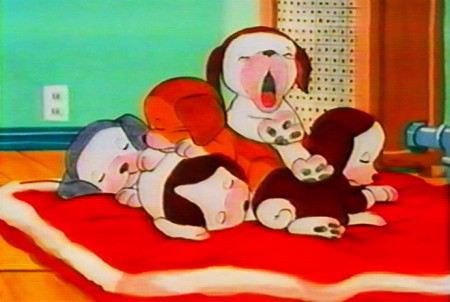 3
3
Ron ran with that treatment and gave me a fine script. I went back to
William Finn to get a couple of musical numbers.
Finn had done a brilliant job for me when he scored Ira Sleeps Over
a couple of years earlier. He had Falsettos on Broadway,
and agreed to do Poky for me. I’d also work with arranger/orchestra
Michael Starobin again to write the incidental score and arrange the songs.
However, I wasn’t prepared for the unexpected.
 4
4
I went to Bill’s apartment and heard the songs as he played them on the piano
and shouted out the lyrics with me listening inches away sitting on his bed.
I was happy that things were moving so quickly and well.
 5
5
However, after that, there was a marked slowdown. The title song was brilliant,
as expected, but I wasn’t crazy about one of the next two he offered me, and
he wanted to rewrite them.
The problem was, I couldn’t get him on the phone after that.
Something was up.
 6
6
After about a month of delay, I brought Michael Starobin in to try to
work with Mr. Finn. Nothing had progressed past that initial sing-out.
Michael said everything was ok and brought me small changes a little at a time.
 7
7
Eventually all the songs were completed, and things progressed.
I found out years later that Bill Finn had had a brain aneurism and was hospitalized
for most of the production time of The Poky Little Puppy’s First Christmas.
I found this out when he’d written a theatrical musical called “THE NEW BRAIN.”
This was about a song writer for a children’s show who had an aneurism and wasn’t
able to complete his job. In fact, he realizes in the hospital that he isn’t creating the
art he’d hoped for. The show’s composer starts writing art songs in the hospital
bed and comes out of a long sterile period of writer’s block.

The artwork for the show moved ahead wonderfully. Liz Seidman was in charge of it all. She had supervised Mike Mulligan and His Steamshovel when that was in production, and she had brilliantly maneuvered from book and storyboard to a great look for the final film.
We decided that a similar look would work well with Poky. By allowing the outside lines of the drawings to be evident throughout the show, we were pointedly saying that this is an adaptation of a beautifully illustrated book, and we’re trying to keep the look of the book’s author.
We did our best to keep the look of Poky and the other characters in the series of books. We watched the first book most closely, although the character had changed some over the years. We did give a nod to those changes, but I loved the original more than any other and stayed closest to that.

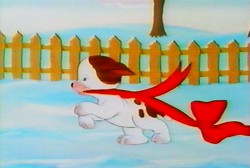 12
12
When we called kids in for voice casting, a ton of 10-12 year olds showed up. There
was only one boy, Chris Seifert, who was closer to 5. He was shy, and he was brilliant
(though my editor wasn’t crazy about all the time we’d have to work with him.)

 14
14
The boy couldn’t read, and I asked his mother not to have him memorize the lines.
When we recorded, I sat in the booth and fed him the lines – one at a time. The
brilliant lad, repeated the words but put his own spin on them. Sometimes I’d push
him to give me a little more, but I knew he was going to work wonderfully as Poky.

 16
16
As for the teen-aged owner of the pups, Grace Johnston was my only choice.
I’d been working with her for years on a number of other projects, and I was in love with
her talent. She’d been Barbara Hershey’s daughter in the film, “BEACHES” and she was a
pro and was every bit as good in Poky as she’d been for me in so many other films.
Now she’s a young, talented beauty out in Hollywood about to take over that town.
 17
17
For Poky’s mother, I immediately went to Heidi Stallings. She’s a great
actress who always surprises me in the recording booth. I love when I
hear the readings in my head and get something completely different from
the actor. 99% of the time that new reading is the perfect one.
This always gets me to laugh in the studio; I love these surprises.
 18
18
Heidi also sings beautifully, and I knew she’d nail the title song:
“My Poky Littly Puppy”. As a matter of fact she sang a version of it
for me, before Michael Starobin had arranged the song. I still hear
that version and wish I had been able to talk Michael into changing
it. Heidi’d sang the song in almost a whisper, and it sounded like a
music box of a song. Beautiful. I like what’s in the final; I just think
there were other possibilities.
 19
19
In animation, I had a great staff for this film. Rodolfo Damaggio led the way.
Years earlier he had arrived at my doorstep with no introduction looking for a job.
Boy could he draw. I put him to work immediately assisting one of my favorite
staff animators, Ray Kosarin.

 21
21
Ray came to me a week later a bit intimidated. He felt that Rodolfo could
animate better than he, and it was tough having such an assistant.
I didn’t agree that he could animate better; he could do the Disney thing
better, but there wasn’t as much heart in Rodolfo’s work.
Just fine, smooth, well-drawn animation.

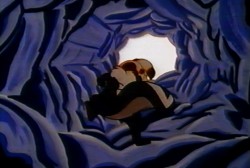 23
23
Rodolfo was perfect for all those four-legged animals.
Dante Barbetta, the great Paramount animator, was also on staff doing some
excellent work. He took whold sequences and made them his own.
Likewise Sue Perrotto who always graced my films with her animation.
 24
24
The rest of the animation staff on this one included:
Eileen Claffy, Ray Kosarin, George McClements, and Tony Kluck.
2 on staff: Ray and George. 2 free-lance: Eileen and Tony.
 25
25
The I&Pt rendering was superbly done by:
Lisa Cupery, Ikuko Tanaka, Stephen MacQuignon, Masako Kanayama,
Christine O’Neill, Michael Klein, Stephen Gambello, Denise Gonzalez, &
Jason McDonald (who also did some inbetweening.)
 26
26
The rendering was somewhat difficult trying to match Tenggren’s tempera colors.
 27
27
My staff used markers, prismacolor pencils on off-white paper. The animation
line served as the outline (the pencil would pick up as a dark grey on camera.)
These drawings were cut out and pasted to the cels before they were sent
to be photographed on film.
 28
28
Liz Seidman did all the backgrounds, herself while
supervising the I&Pt with the help of Masako Kanayama.

A pan home as the family destroys the skunk’s home for the Christmas tree.
 30
30
Somehow for years I’ve recessed this film. I think I’m shy of all the
films I’ve done which were made for toddlers. It’s a gorgeous film
(despite the look of these soft frame-grabs), and I have nothing to
be embarrassed about. Perhaps that’s why I’m showcasing it here.
I apologize for the soft frame grabs. I pulled them from a VHS copy of the film and wish I had had a higher res version to lift from. Alas.
Unfortunately, as I’ve said it’s still not available in DVD. You can find VHS copies of it on Amazon, but that’s really not good enough, if you ask me. Western should get their act together; it’s a good Christmas film.
Articles on Animation &SpornFilms 11 Dec 2010 08:45 am
Sporn-O-Graphics #3
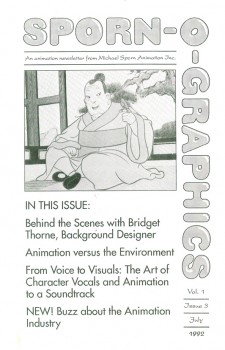 - In 1991, I’d started a small booklet publication, called Sporn-O-Graphics, that I sent out to about a thousand people on my mailing list. Basically, we were promoting ourselves by giving brief interviews and articles about the people in animation who had touched our films in some way. We focused on the films just about to air or were recently completed.
- In 1991, I’d started a small booklet publication, called Sporn-O-Graphics, that I sent out to about a thousand people on my mailing list. Basically, we were promoting ourselves by giving brief interviews and articles about the people in animation who had touched our films in some way. We focused on the films just about to air or were recently completed.
In a lot of ways, it was more fun having a hard copy magazine rather than a blog. It seemed a bit more permanent to have something in your hands, that stayed there until you were done with it.
The third issue, July 1992, concentrated on two specific films, NIGHTINGALE and THE POKY LITTLE PUPPY’S FIRST CHRISTMAS. Denise Gonzalez had just taken over editing the magazine and she conducted many of the interviews and articles for the issue. Her interview with art director/designer, Bridget Thorne, was the key piece, for me, in this issue. She also wrote a bit about voice acting for animation, concentrating on Heidi Stallings who had done the principal adult part for THE POKY PUPPY film.
I’ve posted these two pieces, here, to represent that issue.
 1
1(Click any image to enlarge.)
Here are links to issue #1 and issue #4
Animation &Animation Artifacts &SpornFilms 13 Oct 2010 07:55 am
Soiled Linen
- Here’s something I found the other day. My soiled linen. I did this piece of animation some 49 years ago. I was 15 years old and was trying to do an adaptation of Poe’s short story, “The Black Cat”. I didn’t get too far; as a matter of fact, this is probably all that I did. There’s a painted BG and a storyboard somewhere, but it wasn’t with these drawings.
When I was a kid, I started filming my animation at age 13. By the time I was 17 and starting college, I had shot 2½ hours of 8mm animation. I don’t know what happened to all the other drawings I did, but this scene is all I have. I do have the snippets of 8mm film that I’ll someday transfer to DVD.
Note that I worked on three hole looseleaf for my registration. I don’t think I ever did the missing inbetweens for this scene; if I did, I don’t have them. I don’t ever think I pencil tested this before.
Here’s a smile, some children’s art.
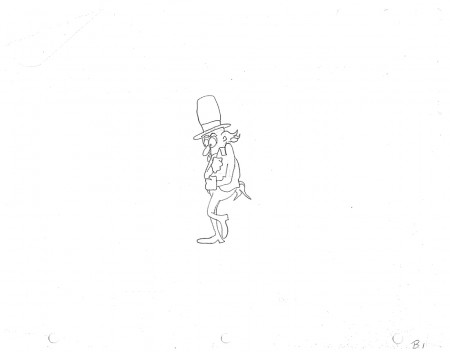 B1
B1
______________________
Here’s a QT movie of the piece.
Remember to take it with a pound of salt.
These are the scribbles of a 15 year old.
Right side to watch single frame.
Music &Photos &SpornFilms 10 Oct 2010 07:59 am
Jazzy Bones
 The Amazing Bone was one of the earlier films I did with Weston Woods. It was an attempt to do Doctor DeSoto one better by taking a more famous book by Steig and adding some richer animation and a lot more attention. John Lithgow was hired to read the book. I flew to LA and back in the same day to get to the recording. (I could’ve done it by phone, but where’s the fun in that?)
The Amazing Bone was one of the earlier films I did with Weston Woods. It was an attempt to do Doctor DeSoto one better by taking a more famous book by Steig and adding some richer animation and a lot more attention. John Lithgow was hired to read the book. I flew to LA and back in the same day to get to the recording. (I could’ve done it by phone, but where’s the fun in that?)
We recorded at the old A&M studio. It was originally Charlie Chaplin’s studio and had ultimately come into the hands of Herb Alpert. I
was early; Lithgow was on time. Our recording engineer was named “Magic.” John read the part brilliantly with few needed retakes. 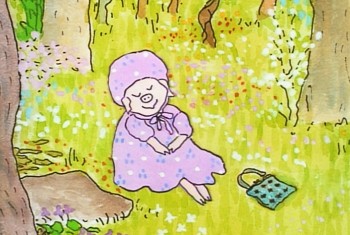 He kept in character for all the voice changes as he read straight ahead. We finished early, and I had a great voice track. I remember exactly the tone of voice when he said goodbye to me, then to “Magic.” He voiced the quotation marks around Magic’s name. I could only smile.
He kept in character for all the voice changes as he read straight ahead. We finished early, and I had a great voice track. I remember exactly the tone of voice when he said goodbye to me, then to “Magic.” He voiced the quotation marks around Magic’s name. I could only smile.
It was a beautiful day, and I had a couple of hours to waste before I had to return my car. So I spent time driving; I love to drive. A lot of touring around Beverly Hills. I remember driving down one quiet street lined with palm trees, and suddenly I realized there was an old clunker of a car tailgating me. I couldn’t imagine what the hell was going on. Then I realized someone was shouting my name. I stopped.
 It was Bill Moritz. He came out gave me a big hug; we chatted for a moment, and he went on his way. It was one of those perfect kind of days. I knew Bill because of his association with Elfriede Fishinger. We’d had dinner countless times in NY with John Canemaker and Joe Kennedy.
It was Bill Moritz. He came out gave me a big hug; we chatted for a moment, and he went on his way. It was one of those perfect kind of days. I knew Bill because of his association with Elfriede Fishinger. We’d had dinner countless times in NY with John Canemaker and Joe Kennedy.
After a brief chat, Bill went on his way, and I continued my lovely afternoon heading back to the airport. It was one of those wonderful days.
The voice track was brilliant when finally edited together and the animation began. We decided to record the music early on in the process. I’d agreed verbally to use Steig’s son, Jeremy, to do the score. I had been a fan of his flute music and owned several of his albums.
The score was performed completely by Jeremy Steig and  the noted bass player Eddie Gomez.
the noted bass player Eddie Gomez.
As a fan of jazz, it was glorious for me to be working with Eddie Gomez, who had once been a member of the Bill Evans Trio. I lived and breathed through Bill Evans‘ music for a long time, and to have only one degree of separation was something I cherished for the short span of that Amazing Bone recording.
(click on any image to enlarge.)
Above:Eddie Gomez confers with Jeremy Steig about the score they’re composing & performing.

 2
2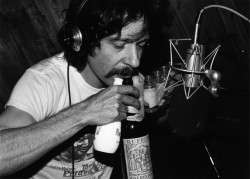 3
3
1. Eddie Gomez plays his bass.
2. Jeremy Steig plays pan pipes.
3. Jeremy Steig plays assorted bottles.
The score took about 7 hours to record and mix.
There were many breaks for Eddie and Jeremy to confer in the bathroom. It got to the point where the engineer/mixer asked them to please stay in the recording session because the breaks were taking longer than the session. They bristled at his comments, and I had to settle things down. However, the more the two went to the bathroom, the slower things got and the music took longer to record. I let things take their own course; the two knew what they had to do.
Regardless, I didn’t care what it took. I was in heaven experiencing the music. The two performers did a great job, and I loved every moment.

During a break Jeremy and I sat down to discuss the music so far. It was great.
All photos were taken by the producer, Paul Gagne. He’s become a long-time friend. I thought I remembered a photo of him with Jeremy, but I don’t have it.
When I did Abel’s Island, another William Steig book, I asked for Jeremy again. This time it turned into hell with Jeremy’s impossible demands late in the production, his new wife writing me foul-mouthed letters, and my having to fire them (although I did pay them in full) four days before the scheduled mix. I hired the talented Arthur Custer to do a score and he had those four days and half the budget Jeremy was paid. I became a full-fledged producer with that decision, and I’m ecstatic with how it ultimately turned out. Despite threats of legal action from William and Jeremy Steig. That was the last Steig book I was allowed to do.
Animation &Independent Animation &SpornFilms 03 Oct 2010 08:00 am
PhotoSunday Recap – Woman of the Year
- Back in Jan 2007, I posted these photos from the animation production of Woman of the Year. I think these are interesting enough that they’re worth revisiting. So here, again, is that post:
 – To recap:
– To recap:
Woman of the Year was a project that came to me in the very start of my studio’s life – 1981.
Tony Walton, the enormously talented and fine designer, had gone to Richard Williams in search of a potential animator for WOTY (as we got to call the name of the show.) Dick recommended me. But before doing WOTY, there were some title segments needed for Prince of the City, a Sidney Lumet film. (I’ll discuss that film work some other day.)
Tony Walton designed the character, Katz, which would be the alter-ego of the show’s cartoonist hero, played by Harry Guardino. Through Katz, we’d learn about the problems of a relationship with a media star, played by Lauren Bacall.
It turned out to be a very intense production. Three minutes of animation turned into twelve as each segment was more successful than the last. ___________(All images enlarge by clicking.)
There was no time for pencil tests. I had to run
to Boston weekly, where the show was in try-outs, to project different segments;  these went into the show that night – usually Wednesdays. I’d rush to the lab to get the dailies, speed to the editor, Sy Fried, to synch them up to a click track that was pre-recorded, then race to the airport to fly to the show for my first screening. Any animation blips would have to be corrected on Thursdays.
these went into the show that night – usually Wednesdays. I’d rush to the lab to get the dailies, speed to the editor, Sy Fried, to synch them up to a click track that was pre-recorded, then race to the airport to fly to the show for my first screening. Any animation blips would have to be corrected on Thursdays.
There was a small crew working out of a tiny east 32nd Street apartment. This was Dick Williams’ apartment in NY. He was rarely here, and when he did stay in NY, he didn’t stay at the apartment. He asked me to use it as my studio and to make sure the rent was paid on time and the mail was collected. Since we had to work crazy hours, it was a surprise one Saturday morning to find that I’d awakened elderly Jazz great, Max Kaminsky, who Dick had also loaned the apartment. Embarrassed, I ultimately moved to a larger studio – my own – shortly thereafter.
Here are a couple of photos of some of us working:
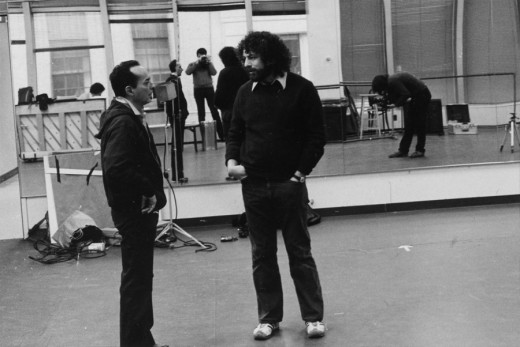
Tony Charmoli was the show’s choreographer. He worked with me in plotting out the big dance number – a duet between Harry Guardino and our cartoon character. I think this is the only time on Broadway that a cartoon character spoke and sang with a live actor on stage. John Canemaker is taking this photograph and Phillip Schopper is setting up the 16mm camera.

Here Tony Charmoli shows us how to do a dance step. Phillip Schopper, who is filming Tony, figures out how to set up his camera. We used Tony’s dancing as reference, but our animation moves were too broad for anyone to have thought they might have been rotoscoped.

John Canemaker is working with Sy Fried, our editor. John did principal animation with me on the big number. Here they’re working with the click track and the live footage of Tony Charmoli to plot out the moves.

Steve Parton supervised the ink and paint. To get the sharpest lines, we inked on cels and didn’t color the drawings. It was B&W with a bright red bowtie. A spotlight matte over the character, bottom-lit on camera by Gary Becker.
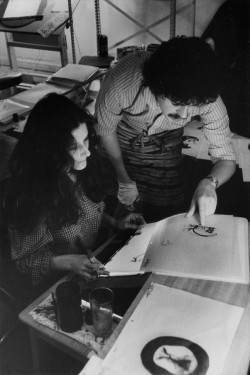 5
5  6
6
5. Steve Parton works with painter Barbara Samuels
6. Joey Epstein paints with fire in her eyes.
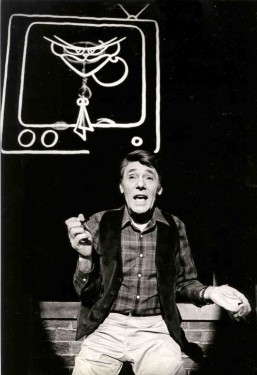 8
8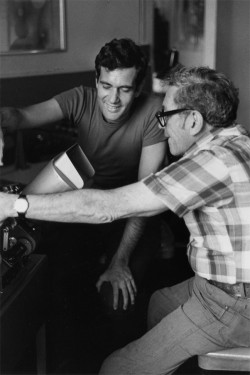 9
9
8. Harry Guardino on stage with the creation of “Tessie Kat” developing on screen behind him. This was Harry’s first big solo.
9. John Canemaker gets to see some of his animation with Sy Fried, editor.

One of my quick stops from the lab on the way to Boston? No, I think this is a posed photo.
The success of the animation (including good reviews) posed a small problem for me. The rest of the show was ripped over the coals. When I started using some quotes about me in industrial ads, the producers came down on me for gloating over the others who’d gotten negative reviews.
All the same, it was a real learning experience in a big Broadway kinda way.
Guest writer &Illustration &SpornFilms 09 Sep 2010 09:28 am
Patti Stren
- I got to know Patti Stren well when we worked together making the short film, MONA MON AMOUR. This was something that Patti had developed as a print piece, and we jointly came up with the idea of making a short. We financed it jointly and love the end product. It’s the film that probably got the most laughs when I saw it projected at the Museum of Modern Art. I was quite proud of it then.
I’m going to turn this post over to Patti to showcase some of her past work including a couple of the many books she’s written and illustrated, some of the print ads she’s done, the post Mona artwork she’s done with the characters, and other material.
I hope you enjoy it.
Often my Canadian friends and here, many of my colleagues; but especially my Mama’s mahjong buddies in their 90′s who watch MONA MON AMOUR every day, as if it were a new film -ask me how did this Michael Sporn and I meet? Then collaborate and then become good friends. Well, for sure I immensely respected Michael’s work. And Michael said some lovely things about mine. Coincidentally, my best friend in Paris, Tana Hoban was the sister of one of Michael’s most beloved Children’s Book Writer Russell Hoban. Of which he animated. The Marzipan Pig exquisitely.

Tana Hoban’s photo of Patti for a flyer.
Actually Michael and I were introduced by the Executive Producer of Babar and Father Christmas to work on a project, that sadly fell through. And then one day Michael invited me into his studio after some wonderfully funny phone calls about work and stuff. I remember telling him,” I’ll bring in my portfolio,” and he said, “don’t.” And I did.
I remember the visit exactly. Michael opened the door to his 632 Broadway studio. He was very tall and I was very small. I was very nervous and said: “I am nervous, and I’m probably going to talk and talk and talk a lot.” And he said: “‘That’s okay. Everything you’ll say will be IMPORTANT.” IT wasn’t that a Large Capital Letter bubble came out of Michael’s head. But when Michael spoke I could tell what he meant in Capital letters! Then Michael led me straight back to the long table at the end of the studio. Where I proceeded talking and talking and talking while showing Michael my Portfolio.

An article from Maclean’s Magazine about Patti.
And, the coincidences in our careers were astounding to me.
I had abruptly come to New York City on a quest to study with R. O. Blechman in a night class at The School of Visual Arts; taking a leap of faith from my first year at The Toronto College of Art. I don’t remember if I showed Michael or told him about my submission for R.O. Blechman’s class book contest: “DRAW the UNEXPECTED.” But I’m Including the illustration now. I had faxed home roughs to my Mom’s mahjong buddies and they had responded to: “not to forget to draw ‘the dangling participles!’”

(Click any image to enlarge.)
Suddenly Michael was telling me that when I was studying with Bob Blechman at SVA, he was either working with Bob or had just opened up his studio around the same time. I was so elated, since I had shyly, after the class had ended, shown HUG ME (the moment it came off the presses), to R. O. Blechman, one evening when he was lecturing. And, later, Bob had redesigned the cover for my second book since the publishers design was hideous. And . . .
I was so nervous we knew the same person I kept turning pages of my portfolio and forgetting to breathe as I was talking. Michael offered me a glass of water. Since Michael had seen all my children’s books he was very patient with the work I was showing. I turned the pages to my favorite MS Magazine illustration I did for them. The Subject: MEN – The Case for Remarriage. . . Among Friends by John Leonard.

The John Leonard article with illustration.
Then In one of the side pockets in my portfolio I pulled out MS MAGAZINE, Sept/1978/, that had the Prestigious Selection for STORIES FOR FREE CHILDREN. And HUG ME was in that section.
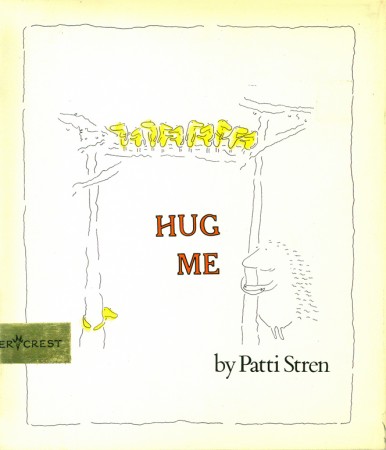
HUG ME book cover and two page spread (below).
Michael and I had already talked about HUG ME, my book published by Harper & Row at the time. And . . .
Producer Nick Bosustow animated HUG ME as part of the CBS LIBRARY SPECIAL called 4 WISHES. Winning 1st Prize at Zagreb Film Festival in Children’s Film Category in 1984.
 a
a  b
ba. The back cover of the video cassette.
b. The front cover of the audio cassette.
Michael seemed to know everyone I talked about in the business of film. HE had this way of making me feel comfortable, and I kept talking and talking and I confided to Michael that when writing for children I never really try to just write for children but for myself. And I never really planned things out. And Michael described how he created spontaneously in his films. Especially describing the broom closet scene in Lyle Lyle crocodile. . The more he spoke the more Michael reminded me of another gentle genius writer I knew. The wonderful and understanding and exceedingly exciting Writer John Gardner. Who always used to tell me to ignore intellectuals snobs that would act superior and to promise to be myself. Then Michael told me, that not only did he know John Gardner but that he illustrated for John Gardner too. And then we both discovered that John had sent us to the same Random House art director to be published by them. And how we’d both been sent away The coincidences kept adding up.

Blythe Danner and Patti Stren
Then Next in my portfolio were the most wonderful photos of Blythe Danner and myself. Always to remind me how happy I am that Blythe Danner Narrated the recordings of HUG ME and Other stories of Patti Stren.
Michael seemed pleased to see Blythe, since he had been really wanting to work with her, but the times had never coincided. Now I have all the rights back for the recording, and I am hoping to get Hug Me animated with the pages turning with Blythe’s narrating. Hopefully with Michael animating. And hopefully with a grant again as with many of my projects.

(above) The two page book cover for another of Patti’s books, SLOAN & PHILAMENA
(below) and two sample pages.
Finally I showed Michael my Secret Book Jacket Cover to my next Book in The Works! Therapy. Sex and Shopping. What Else is There in New York City. ( Except Alternate Side Parking!)
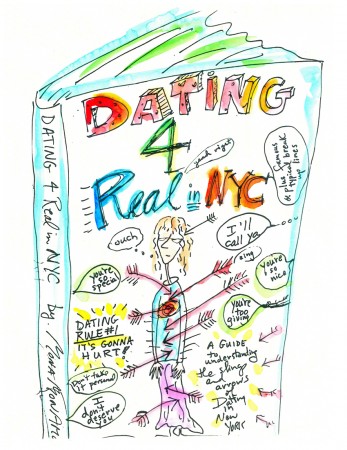
Sample covers.
Little did I know showing my main character MONA MON AMOUR with the caption underneath her saying: Mona was convinced that she’d lost the meaning to life. Her therapist told her she’d just misplaced it –Would lead to our collaboration.


Patti’s creativity with Mona is endless.
And when I stopped talking to Michael Sporn about all these ideas I had; I thought I was going to faint. . . . I’d forgotten to breath. And when Rich my husband picked me and my portfolio up in our car; I had no idea Michael would want to make a film with me. But I knew if he did – I’d say yes!

And Now heaps of years in the business, 1′m still having fun designing animated shorts, (the latest animation for Michael again), working on books (both adaptations from the two short animations, MONA MON AMOUR and the little genius Mozart).

A scene from the Mozart film.
And I’m back to my Commercial Art Career. I’m available 24 hours a day, now designing for Eppes Essen Deli, in N.J. in hopes that Eppes will Fed Ex me Heaps of Chopped liver!

Animation &Frame Grabs &SpornFilms 15 Jul 2010 07:08 am
Child Development
- I want to give some attention to a series of films we did for UNICEF back in the 90′s. There were four films which focussed on Child Development, trying to teach parents in the Third World how to take care of their children in the first eight years of development.
These films were brought to me by one, Cassie Landers. A well trained educator and an employee of Unicef where she promoted child development training and was hoping to use film to get the message across to the Third World.
Primary to these films was to get the point across that females deserved as much attention, including education, as the boys did. This is a major problem throughout the world, and UNICEF has done an entire series specifically for India about it.
Our aim was to encourage good diet, good behavioral practices and, again, the importance of a good education. The four films were ultimately combined with some live action footage of T. Berry Brazelton talking with children and introducing each of the four segments.
Hillary Rodham Clinton, as First Lady, introduced the entire 1/2 hr. show.
Here are some frame grabs from about 2/3 the scenes of the first film, Off To A Good Start.
 1
1
 2
2
After the UNICEF logo, the film started with a montage of children’s faces.
 3
3
I’ve compiled about a third of the faces.
 4
4
The camera continually moves in on the faces while …
 5
5
… constantly dissolving to the next setup.
 6
6
This was the opening to all four of the films.
 7
7
It was accompanied by narration by Celeste Holme describing the films about to be seen.
 8
8
The narration was written by UNICEF Producer/educator, Cassie Landers.
Sue Perotto drew all of the children’s faces for the opening. She had the right sweet look for the children and the many faces we’d be seeing in a very short amount of time. I knew Sue could keep it interesting and I depended on her – with good reason.
 10
10
The first film started with prenatal care.
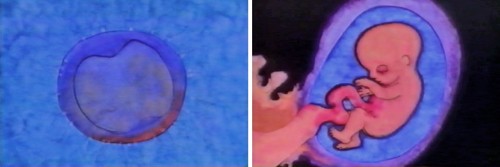 11
11
Giving a very short the child in the womb.
 12
12
Right through to the actual birth.
 13
13
Then it jumps to the first year of development.
 14
14
The art style was designed after Matisse’s Moroccan paintings.
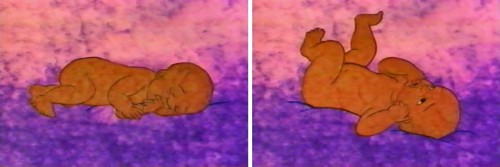 15
15
He had a very primitive set up, colors with
earth-toned characters dominating their paintings.
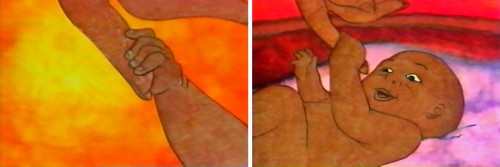 16
16
We tried to reproduce the feel of these paintings
allowing the texture of the paintings to run and bleed.
 18
18
This was all done pre-computer days, so all art was
painted on paper, then cut out and pasted to cels.
 19
19
It was all shot on camera by Gary Becker at his FStop Studios.
Masako Kanayama and Stephen MacQuignon were able to bring a smooth look to the wildly varing colors.
It was designed to look like Matisse’s African period, and I think it did.
 20
20
The first year continues with similar setup.
 21
21
After showing some advanced activity . . .
 22
22
. . . we show how the brain has started to . . .
 23
23
develop enormously in this first year.
 24
24
The child learns to get up and crawl.
 25
25
From here she learns to walk.
 27
27
Then he learns to play more sophisticated games . . .
 28
28
. . .utilizing tools that require more dexterity and thought.
Directed by Michael Sporn
Produced and Written by Cassie Landers EdD, MPH
Narrated by Celeste Holme
Music by David Evans
Production Coordinated by Masako Kanayama
Backgrounds by Jason McDonald
Edited by Ed Askinazi
Photography by FStop Studio – Gary Becker & Bob Bushell
Technical Consultant Marc Borstein Nat’l Inst of Health, Bethesda MD.
Office Manager Marilyn Rosado
Animation by Rodolfo Damaggio, Sue Perotto, Michael Sporn
Rendering by Christine O’Neill, Matt Sheridan, Stephen MacQuignon, Masako Kanayama
Special Thanks to Nigel Fisher, Deputy Regional Director,
UNICEF Regional Office for the Middle East and Africa



